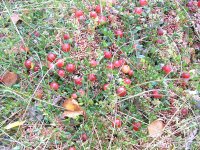Cranberry four-leaved (marsh) - oxycoccus quadripetalus (oxycoccus quadripetala)
Family Heather - Ericaceae
Botanical characteristics. Cowberry family. Evergreen shallow shrub with creeping shoots up to 30 cm long. Leaves are alternate, lanceolate, on short petioles, green on top and silvery below. Flowers are small, dark pink or purple, regular. Blossoms in May-June. Fruit is a globular, acidic berry of dark red color, ripens in late autumn.
Spread. Swamp plant. A widespread wild-growing berry of the northern and middle regions of the European part of our country, Siberia and the Far East.
Used parts of the plant.
Mature berries collected in the autumn after frost or early spring.
Berries of cranberries contain acids (quinine, citric, benzoic, oleanic, ursol), sugar, vitamin C (up to 22 mg%), glycoside vaccine, pectin substances and pigments.
Application.
With various febrile illnesses like antipyretic, vitamin and thirst quencher. Cranberry juice is given to the postoperative patient, with angina, influenza, rheumatism, malaria; As a weak vasodilator is recommended for angina pectoris.
In folk medicine with a curative purpose, cranberries are recommended for all diseases of the kidneys and urinary tract. When prescribing a salt-free diet to renal patients, the addition of cranberry to the food improves its taste and partially replaces the absence of salt. Drinks from cranberries have not only an independent bactericidal effect, but also significantly enhance the therapeutic activity of other antibacterial drugs used to treat kidney and bladder.
Preparation. Berries are eaten with sugar and honey, syrups, juices, sour drinks are prepared.




Comments
Commenting on, remember that the content and tone of your message can hurt the feelings of real people, show respect and tolerance to your interlocutors even if you do not share their opinion, your behavior in the conditions of freedom of expression and anonymity provided by the Internet, changes Not only virtual, but also the real world. All comments are hidden from the index, spam is controlled.